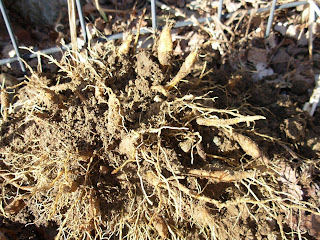These are photos of Groundnut, Apios Americana, which I wrote about on 11-14. It gets quite viney, as you can see by how this one has grown right up the tall support pole for one of our bird houses.

Once you become familiar with it, it becomes quite easy to identify as it grows on top of other plants and has very distinct leaves.

This is the area under the Blue Spruce, which had been so overgrown that it was impossible to see what was trying to grow there. This is what it looked like before the pruning of the Spruce. The Lamb's Ears was totally overgrown by the heavy Spruce branches.

And this is what it became once the lower branches were pruned back. Now you can clearly see the group of Lamb's Ears, Stachys Byzantina, which had been coping with the crowded area.

The Lamb's Ears is now joined by its new neighbor, Heather, which was transplanted out from the entanglement of Bittersweet roots.

This Heather is due for a much better time in the spring when it will have the opportunity to grow free of the Bittersweet roots that it had been plagued with.

Interestingly I found several patches of Lamb's Ears seedlings getting ready to be moved on to new homes next year. It is the first time they have seeded themselves!!















































